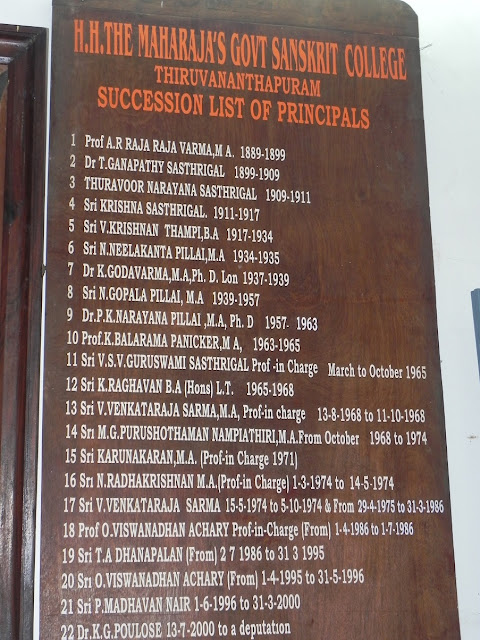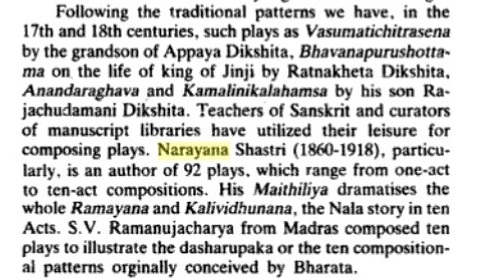Dr. Christophe Vielle of UCLouvain - Institut orientaliste, Belgium, provides key answers to my questions on my ancestor Turavur Narayana Sastrigal's Sanskrit/Devanagari transcription work on Vyangyavyakhya
Last updated on 29th May 2020
Copied with link update from ravisiyer.blogspot.com on 14 Apr. 2023, first published there on May 26, 2020
The background to this post is my recent post: My ancestor Turavur Narayana Sastri named in 21st century books & journal as 1915 Sanskrit transcriber of ancient Tapatisamvarana-dhvani & Subhadradhananjaya-dhvani (Vyangyavyakhya) Kerala drama commentaries related to Kutiyattam, https://tnarayanasasthri.blogspot.com/2023/04/my-ancestor-turavur-narayana-sastri.html .
As mentioned in the above post, Dr. Christophe Vielle (of UCLouvain - Institut orientaliste, Belgium, http://www.cbs.ugent.be/node/553) has reviewed Dr. K.G. Paulose's book, Vyaṅgyavyākhyā: The Aesthetics of Dhvani in Theatre, published in 2013, in an article in 2017 Cracow Indological Studies, Theatrical and Ritual Boundaries in South Asia journal.
Dr. Christophe Vielle kindly and quickly responded to my mail to him having some questions about my great-grandfather Turavur (Thuravoor) Narayana Sastrigal's (TNS) Sanskrit/Devanagari 1915 transcription work of Tapatisamvarana-dhvani & Subhadradhananjaya-dhvani (referred to by TNS as Dhanañjayasamvaranadhvani, and which seems to be more well known now as Vyangyavyakhya) mentioned in Dr. Paulose's book.
He also sent me (privately) a picture of the page of Dr. K.G. Paulose's book, Vyaṅgyavyākhyā ..., having a picture of the first page of this TNS transcribed Sanskrit paper manuscript. I was very happy to see this picture.
As I have mentioned later in this post, I have ordered a copy of this book of Dr. Paulose. Once I get it, I will try to take a high-resolution pic of this page of the book, and provide that pic (to be taken by me) in this post. As the manuscript itself would surely be out of copyright under Indian law (as it is over 100 years old), and as it would be very appropriate to provide credit to the book in which it appears, I plan to publicly share that pic (to be taken by me) on this post.
The vital text clarifications, confirmations and explanations (besides private pic mentioned above) that I got from Dr. Christophe Vielle's mail are:
a) "The text is in 310 pages - 1 to 124 Dhanañjayadhvani and 125 to the end Samvaranadhvani. The common title for the two texts in the codex is Dhanañjayasamvaranadhvani." - These sentences seem to be in page 67 of Dr. Paulose book (Vyangyavyakhya ...) and refers to transcribed in Sanskrit manuscript text written by TNS.
b) Dr. Vielle confirmed that the whole Sanskrit text of VyangyaVyakhya (Dhanañjayasamvaranadhvani) is given in Dr. Paulose book.
c) He mentioned that the book has only one picture of the transcript manuscript.
d) I clearly understood Dr. Vielle's explanation to me that Sanskrit was written in Malayalam script (in the palm-leaf manuscript), and so TNS only changed the writing script from Malayalam to Devanagari, and therefore was only the transcriber (with no translation done by him).
e) Dr. Vielle informed me that the transcripts made at that time are at the University of Kerala (Kariavattom campus). While I personally, due to some issues, do not travel now, once the COVID-19 pandemic comes under control in India, I will surely explore the possibility of requesting somebody to visit the campus, and, after acquiring due permission from the authorities, see this particular script transcribed by TNS and take a pic of the part of it (say at the end of the manuscript) that mentions that TNS is the transcriber.
---------
Based on Dr. Vielle's clarifications, confirmations and explanations, I am now sure that this book authored by Dr. K.G. Paulose will be a valuable heirloom for the family and so have placed a pre-paid order for one copy on Amazon India, https://www.amazon.in/dp/8124606994/. Total price for it (including shipping to my residence in Puttaparthi) is Rs.1087.
I profusely thanked Dr. Christophe Vielle over email, for his email response referred above. I take this opportunity to publicly thank Dr. Christophe Vielle for the great help he has provided in this matter.
As an aside, I had spent a year or slightly more in Brussels in the mid 1980s, on my first foreign software assignment (from a Bombay based software company), to a company called Wang International Telecommunications Research Centre (ITRC) in Brussels, with HQ in USA (Wang Laboratories, https://en.wikipedia.org/wiki/Wang_Laboratories). I have very fond memories of my stint in Brussels and my interactions with Belgian as well as many other European people there. So I am very glad, and also quite astonished, that a researcher with a Belgian university has provided these clarifications, confirmations and explanations to me about Sanskrit/Devanagari transcription work done by my great-grandfather in Trivandrum (Thiruvananthapuram), Kerala, over a century ago!
[Just in case some readers want to have a quick look at my hastily written account of my Belgian stay in mid 1980s (part of it is related to computer technology but good part of it is about my general life in Brussels then and my views on it), they may have a look at pages from around page 80 to 99 in this part-autobiography book PDF (Google Drive) Download link (4 MB): https://drive.google.com/open?id=1_dFuX_oNd9iUy7z7fqAXbuyMRtPJRr2U .]



Comments
Post a Comment